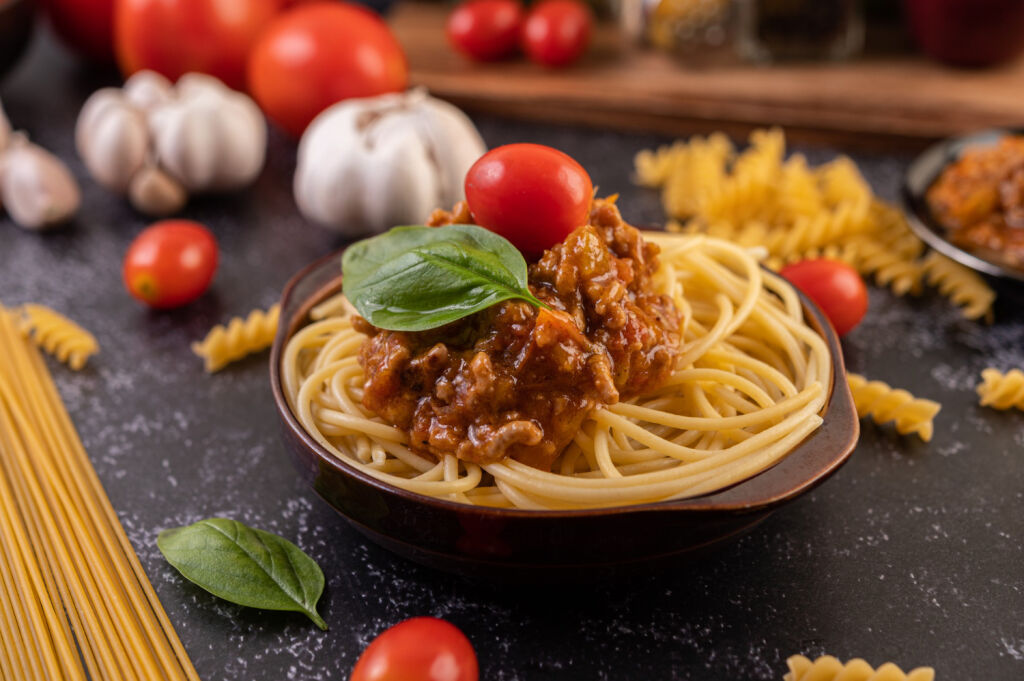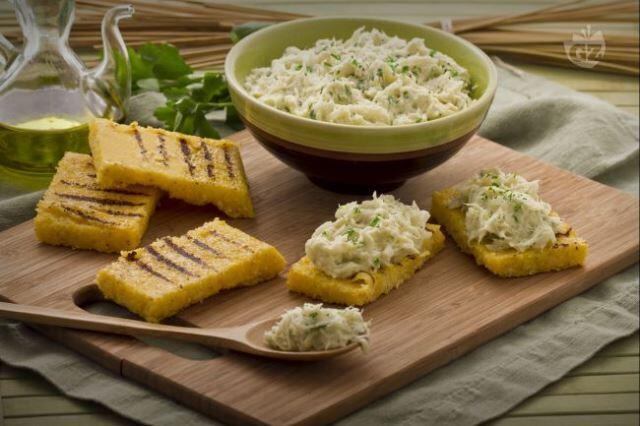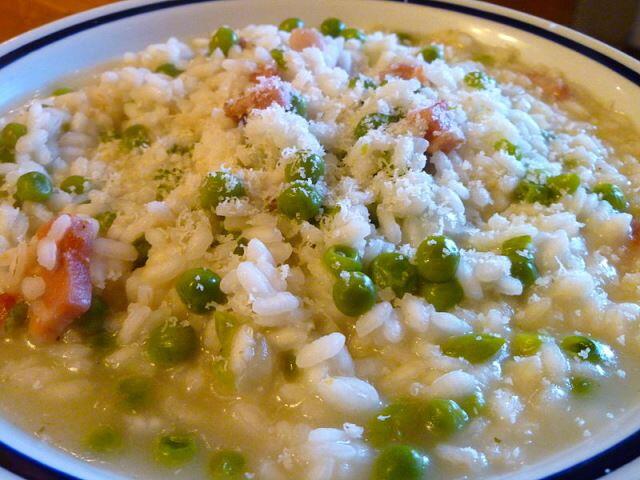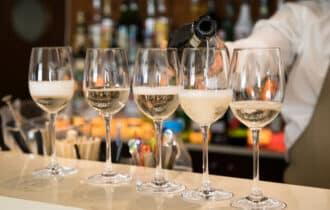When people think of Venice, they envision picturesque canals, enchanting gondola rides, and refreshing glasses of Aperol spritz. Venetian cuisine often gets forgotten about. However, the foodie landscape here is well and truly alive and kicking, and I’m going to give you the inside scoop!
You’ve probably been led to believe that Venice is filled with overpriced restaurants and mediocre touristy dishes, but trust me, this isn’t the case. There are so many amazing foods you have to try in Venice. Baccalà mantecato, anyone?
I see Venice as my second home sometimes because of how much time I spend there. I understand the food industry in Venice pretty well for a foreigner. So, let me show you some of Venice’s best foods I think you should try when you get here.
1. Sarde in saor
This delectable agrodolce or sweet-sour recipe is definitely one of my favorite Venetian dishes.
Its ingredients include fried sardine fillets marinated in vinegar, onions, raisins, and pine nuts. The sauce sure does give it an overpowering sweetness, but because the fish is rich and oily, it adds a savory side to the dish.
I love it when the chef adds a good olive oil to the cooking process because it really strengthens its richness and brings some peppery undertones to it.
Saor was originally conceived in the Middle Ages by Venetian sailors and fishermen as a preservation method. With modern refrigeration, preserving fish (and other foods) in this way is no longer necessary.
However, the simultaneously sweet and tangy flavors characterizing this preservation method were clearly very appealing to the Venetians’ taste buds, and, as a result, the dish lives on as a modern-day antipasto or appetizer.
If you want to try sarde in saor in Venice, go to Bar All’Arco. It’s a tiny haunt where many locals love to eat; there’s a real buzz about the place whenever you go. Their sarde in saor is one of the best out there; between the freshly caught sardines and the high-quality vinegar, it’s perfect.
Bar All’Arco (€€) – S. Polo, 436, 30125 Venezia VE, Italy – Thursday to Monday, 10:00 am to 2:30 pm, Tuesday, 10:00 am to 5:00 pm, closed on Wednesday
2. Baccalà Mantecato
Coming in next is another sublime fish-based antipasto. Baccala mantecato or creamed dried cod, is prepared by soaking, poaching, and blending the fish into a smooth mousse seasoned with olive oil, salt, and pepper.
I find the taste to be very salty and garlicky. The fish obviously brings some saltiness to the mix, but fortunately, it’s never too strong because of the added garlic flakes. Plus, it can be somewhat creamy; I prefer it this way because the cod transforms into a spread, making it easier to digest.
Baccalà mantecato dates back to 1431 when a ship filled with spices got stuck in a storm in the English Channel. Those who survived were picked up by fishermen and brought to Roest Island in Norway.
There, they taught them how to cook with stock fish, and when the captain went to Venice, he brought some of the fish with him. He showed the Ventians how to prepare the stockfish and make a mix out of it, which we call Baccalà Mantecato today.
You have to try the baccalà mantecato at Trattoria Al Gazzettino. It’s a nice little stop along the way if you have plans to visit Casino Venier; there’s such a bustling atmosphere that you’ll never want to leave.
The baccalà mantecato was served to me with a mix of creamed cod and polenta. I didn’t think the cod was too briny because the creamy sauce’s butteriness masked it. The polenta had some slight nutty undertones, and as I bit into it, there was a sudden crunch because it was grilled.
Trattoria Al Gazzettino(€€) – C. de Mezzo, 4997, 30124 Venezia VE, Italy – Every day, 12:00 pm to 4 pm, 6:00 pm to 10:30 pm
3. Risotto al nero di seppia
Rice is the other commonly grown staple in the Veneto region, and few dishes are more Venetian than this must-try seafood-based risotto called risotto al nero di seppia.
The squid ink in this primo or starter may confer a rather alarming and seemingly unpalatable jet-black color to the rice. I was scared, too, at first, but the robust umami smell that came from the person’s order on the table beside me really lured me in.
This dish, though, wins even the most skeptical visitors over, including me, with its distinct brine flavor of squid, wine, onion, tomato, and ink braise. I loved the ink in particular; it gave it a proper zest and paired surprisingly well with the creaminess from the risotto. It was completely unlike the risotto you would find in Milan.
It’s funny because the idea of risotto al nero di sepia came from a time of hardship when Venetians needed something to flavor the risotto, and squid ink was the only thing available.
One restaurant in Venice I brought my family to try some traditional dishes including risotto al nero di seppia, is Osteria al Portego. We were all blown away by it. The risotto rice was of amazing quality, absorbing the squid ink and giving it a solid texture.
Osteria al Portego (€€) – Calle de la Malvasia, 6014, 30122 Venezia VE, Italy – 11:30 am to 10:00 pm, every day
4. Risi e Bisi
My Venetian food guide would not be complete without mentioning another rice-based starter, risi e bisi or Venetian-style rice and peas. It’s the ultimate comfort plate with scrumptious ingredients, vialone nano rice, pancetta, onion, butter, parsley, and, surprisingly enough, pea-shell broth!
While I like most risottos, risi e bisi really stands out to me. Its flavor profile is unique, with the peas adding a saccharine tinge and the prosciutto giving it some brackish notes. Nothing beats the melted goodness of the parmesan on top, though; it gives it a sharp edge with a nutty tang.
To really try the best risi e bisi, you should come to Venice during spring because it’s when the peas are in their season. If you notice fresh peas gracing the stands at the Rialto markets, you can be sure that it is the right time to sample this dish at a local trattoria.
On April 25, St. Mark’s Day, this primo was served as an offering to the Doge of Venice from the peasantry from the lagoon islands. The upper class saw it as a dish for celebration, whereas nowadays, nobody really cares.
Venice is located in Veneto, one of the country’s main risotto-producing regions, so expect fantastic risotto wherever you order this dish. But one place, in particular, you should go to is Ai Garzoti; it has everything: gorgeous location by a canal, friendly staff, and some of the best risi e bisi.
I found the consistency of the risi e bisi to be velvety; it wasn’t too lumpy, though; I would describe it as almost broth-like. There was a strong scent of onions and garlic as it was dropped on the table, which contributed to the overall character of the dish.
Ai Garzoti (€€) – o dei Garzoti, Fondamenta Rio Marin, 890, 30135 Venezia VE, Italy – Every day, 11:00 am to 3:00 pm and 6:00 pm to 10:30 pm
5. Bigoli In Salsa
Bigoli in salsa is another signature starter dish of Venice. Bigoli, or bigoi as they are called in the local dialect, are essentially long, thick, whole-wheat strands of pasta resembling spaghetti.
A salsa or sauce consisting of onions and salt-cured fish (sardines or anchovies) is then used to accompany the pasta. Traditionally served on giorni di magro or lean days such as Good Friday and Christmas Eve, this simple but delicious dish is now served all year round in Venice.
Bigoli in salsa used to be eaten by peasants back in the 16th century because of how cheap it was to make. Plus, it was a convenient go-to on major fasting days during the year, like Good Friday.
My favorite part about bigoli in salsa is undoubtedly the sauce. It’s derived from slow-cooking onions, olive oil, anchovies, white wine, and garlic in a pan. The end flavor combines sweet and savory profiles that bring a balanced character to the dish. It should have a light thickness to it.
I had a gorgeous serving of bigoli in salsa before at a restaurant called Very Good. It’s a little bit outside of the main tourist center, but it’s so worth going to just for this dish.
It was my first time trying bigoli spaghetti, and I loved it; it almost reminded me of udon noodles, although they weren’t as thick. I did think the sauce had an intense seafood flavor; the taste stayed in my mouth for quite a while after, but luckily, it tasted good.
Very Good (€€) – Fondamenta Cannaregio, 961, 30121 Venezia VE, Italy – Every day, 11:30 am to 11:00 pm
6. Fegato alla veneziana

If you consider yourself an offal enthusiast, you’ll relish this main course made with calf liver and stewed onions. There’s so much I love about this dish, including the earthiness of the liver, which is complimented perfectly by the sweet, caramelized onions.
With its distinct flavor combination, this classic Italian food has been known to convert many visitors who claim not to like liver. I must admit, I wasn’t even a big fan of liver before trying it, but now I’m always looking out to see where I can get my hands on some.
Another great feature of fegato alla veneziana is that it is often served on a creamy bed of polenta, adding a lightly sweetened corn taste to the dish with every bite.
La Bitta Restaurant is one of my go-to haunts in Venice for some fegato alla veneziana. I know I’m always guaranteed an outstanding meal whenever I go there.
Their chefs really know their stuff regarding fegato alla veneziana. It’s some of the tastiest calf liver I’ve ever tried, and when it’s mixed with the caramelized onions, it’s heavenly; I bet you’ll have a yearning for distinct caramelization on the onions for years to come.
La Bitta (€€) – C. Lunga S. Barnaba, 2753/A, 30123 Venezia VE, Italy – 7:00 pm to 10:00 pm, Monday to Friday
7. Mołéche
The Venetian lagoon is home to all sorts of wonderful crustaceans, making Venice the perfect place for seafood lovers.
Moleche, small green crabs, are a seasonal springtime delicacy eaten after they shed their shells. These crabs are delicately soft and tender and lend themselves well to fried dishes and salads.
Speed is required when the crabs are harvested, as within a few hours, they form new shells that harden after contact with water.
You don’t want to come to Venice without trying the mołéche at Trattoria Al Gatto Nero. Now, this spot is not on the mainland; it’s actually on the small island of Burano, which is only a short ferry ride away and totally worth venturing for just to try their mołéche.
I’m a big seafood eater, and I can even admit the mołéche here had a strong brininess because they’re harvested in saltwater. It also had a nutty aftertaste, which usually tells the crab has been fried; I really enjoyed this side of it.
Before you think about going, you need to be aware this dish is seasonal, so they’ll only sell it during autumn and early spring.
Trattoria Al Gatto Nero (€€) – Via Giudecca, 88, 30142 Venezia VE, Italy – Tuesday, Friday, and Saturday, 12:30 pm to 3:00 pm, and 7:30 to 9:00 pm, Wednesday, Thursday, and Sunday, 12:30 to 3:00 pm, closed Monday
8. Baicoli
When the Republic of Venice was a great seafaring power, sailors needed food that would last during their often long and precarious voyages.
Among their most important rations were the dry, oval-shaped, and, most importantly, long-lasting baicoli or ship biscuits. Although they deceptively appear simple, preparing them is actually a very long process as they require two rises and double baking.
These biscuits are made with flour, sugar, olive oil, milk, and water. I find them to have a strong buttery taste and a crispy texture. They’re like mini desserts and don’t make me feel bad about myself because they’re so small.
Many Venetian aristocrats were fond of dipping baicoli in creams and dessert wines. These days, you’ll generally find them served with coffee and zabaglione.
You can buy some baicoli in pretty much any pastry shop in Venice. I suggest you try them in Dal Nono Colussi, a generations-old store in a quieter part of town. They bake everything right in front of the customers; I could have sat there all day watching them work their magic.
When I ordered the baicolo, they served it to me with Zabaione, a dessert that’s made with egg yolk, sugar, and sweetened wine. I couldn’t resist dipping the baicolo into it; it was very rich and tasted of strong vanilla extract.
Dal Nono Colussi (€€) – Tuesday to Saturday, 8:00 am to 12:00 pm and 3:00 to 6:00 pm, closed on Sunday and Monday
9. Fritole
If you’re lucky enough to be visiting during the Carnevale (Carnival) period, then you must try fritole. These are sweet pastry fritters traditionally prepared and eaten as part of the festivities before Lent.
Made with a rich batter consisting of flour, eggs, butter, milk, sugar, pine nuts, and raisins, they are molded in balls, deep fried in oil, and dusted with sugar. It’s no wonder why I highly recommend these for those with a sweet tooth!
When I tried these little things for the first time, I knew they’d be sweet, but I didn’t realize there would be such a citrusy aftertaste. A lot of cooks make them with lemon for an added kick, and it really boosts their taste.
Although fritole are made mainly around the time of Carnevale, I still managed to find them in pastry shops like Pasticceria Toletta. I found this spot by chance while walking by the canals on my last trip to Venice.
I ordered four of the fritters as a snack, and they came stuffed with chantilly, adding a smooth, luscious creaminess to them. They may look small when you’re ordering, but they’re extremely filling.
Pasticceria Toletta (€) – Ponte de le Maravegie, 1192, 30123 Venezia VE, Italy – Monday to Friday, 7:30 am to 7:30 pm, Saturday and Sunday, 8:00 am to 7:30 pm
10. Polenta e Schie

An appetizer I turn to often when I’m visiting Venice is polenta e schie. It’s a dish where boiled polenta is spread across a plate, and a couple of shrimp called “schie” are placed on top, often seasoned with delicious herbs to really bring out the flavors.
It’s hard to imagine that polenta e schie was a poor man’s dish in the old days because it has recently become quite expensive. The schie are becoming more difficult to source, so local fishermen have increased the prices, having a knock-on effect on the price in a restaurant.
I tried polenta e schie for the first time at the gorgeous Poste Vecie, a fascinating restaurant in an old post office that dates back to the 1500s. I was visiting the nearby Church of Saint Cassian and passed by on the way back to my hotel; it looked gorgeous, so I thought I would give it a go.
Initially, I didn’t think the combination of this local food would taste so nice, but after one mouthful, I was sold. The sweet corn flavor from the polenta tasted slightly earthy, but the schie was cooked in a lemon-infused sauce, giving it a zesty kick.
The polenta was quite mushy, which was a positive because the grains could absorb all the liquid. In contrast, the schie was very tender, but the two paired well, hence why it’s always listed as one of the essential foods in Venice you have to try.
Poste Vecie (€€) – Mercato del pesce di Rialto, San Polo, 1608, 30124 Venezia VE, Italy – Wednesday to Monday, 12:00 pm to 3:00 pm and 7:00 pm to 10:30 pm, closed on Tuesday
11. Cicchetti

You’ll be surprised at how much cicchetti you’ll eat in Venice; it’s hard to escape it. These little nibbles are what everyone knows the city for (after the canals, of course). They come in various forms: grilled meatballs, cold meats, cheeses on toast points, and deep-fried arancini.
The name “cicchetti” translates to “small plates” in English, and they sure are small. Fortunately, when you order some, they usually give you a few different samples, allowing you to try a plethora of snacks.
Additionally, you’ll normally be instructed to buy a drink with your order, either a glass of wine or an Aperol spritz for most people. Most of the time, a drink comes with an order at happy hour anyway.
To get some proper cicchetti, you need to go to a bacari (cicchetti bars); these are adorable little wine bars all over Venice. One of the most famous is Al Mercà, which is seconds from the Rialto Bridge.
I was astounded at the selection of cicchetti they have here. They were very inexpensive; I went for the jelly-like prosciutto, cheese, and bread, which was delightful.
The prosciutto had a strong umami taste; it perfectly matched the soft, tangy cheese. Also, the glass of Ca Dei Frati went down a treat.
Al Mercà (€) – Campo Bella Vienna, 213, 30125 Venezia VE, Italy – Monday to Thursday, 10:00 am to 2:30 pm and 6:00 pm to 9:00 pm, Friday and Saturday, 10:00 am to 2:30 pm and 6:00 pm to 9:30 pm, closed on Sunday
12. Nero di Seppia
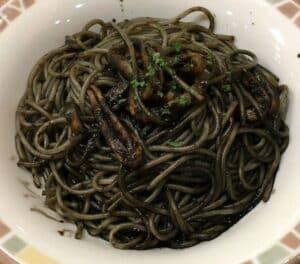
13. Wine
The Veneto region has a remarkably varied landscape and is home to a variety of microclimates, creating the perfect conditions for growing both quality red and white wines.
The sparkling white wine Prosecco – and other concoctions such as the Bellini and Spritz that are made with it – has become quite fashionable as a pre-dinner drink lately.
However, if I had to choose a white wine to accompany the fish I eat when I’m in Venice, I’d choose a bottle of Soave. I can’t get enough of this one; it has some unique melon and orange zesty flavors and even a slight tinge of saltiness.
If I were to accompany a heartier dish, I’d stick to a red like Valpolicella or Amarone. The sour cherry taste is what does it for me with this one; it almost has a slightly chocolaty aftertaste, which I find intriguing. As soon as you pop the cork, the herby aromas will tempt you for a glass or two.
Wine bars are in abundance in Venice; I’m not exaggerating; you can find them literally everywhere. One that I’m sure you’ll enjoy is Vino Vero. It’s a canal-front lounge with gorgeous wooden interiors and a warm ambiance, everything you need to enjoy a fine glass of Venetian vino.
The Prosecco I sampled here was exceptional; it wasn’t too acidy and had many layers of flavor, like lemony notes and pear-tasting undertones. The bubbles were so refreshing after the 10,000 steps I got in wandering through Venice’s endless alleyways.
Vino Vero (€€) – Fondamenta de la Misericordia, 2497, 30100 Venezia VE, Italy – Monday, 5:00 pm to 12:00 am, Tuesday, Wednesday, Thursday, and Sunday, 12:00 pm and 12:00 am, and Friday and Saturday, 12:00 pm to 1:00 am
Conclusion
I hope I haven’t spoiled you for choice too much with this article on the best foods to try in Venice.
Venice’s cuisine is a delight regardless of whether you’re coming from abroad or a domestic tourist. It’s so diverse that you can easily try something new for every meal when you’re here.
Discover the finest foods to come from the city on one Eating Europe’s wonderful Venice food tours. Link up with a local guide and experience some gourmet delights in hidden eateries all over the City of Canals.

